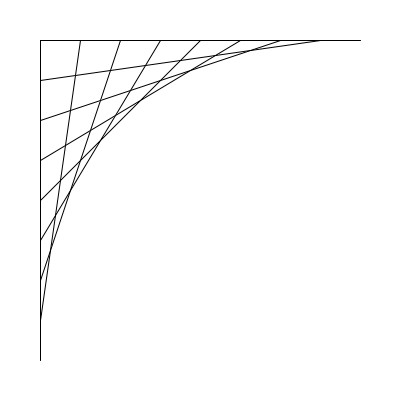Quiz 1 Results
On Monday 9/12 we had a three-part quiz. Results are posted here.
Solutions by Golan and Craig can be found in the Quiz responses.
==============================================
Quiz 2011-09-14-A
// 10 points total:
// A series of lines are drawn on the canvas.
// Their endpoints are equally spaced.
// 9 points: Using an iteration structure.
// 1 point: Aesthetics / veracity of copy / attention to detail.
// You must reproduce this image as accurately as possible:
quiz-2011-09-14-a.jpg

| Adelaide | 3: problem in observation or execution? poor code formatting isn’t helping. |
| Alan | 10: excellent work (except for the carelessly unspecified background). |
| Alex | 10: perfect solution, plus interesting use of HSB mode. Nice! |
| Caroline | 5: failed to implement core algorithm (single, not double iteration). |
| claire | 8: basically good work, but wrong number of lines & poor visual alignment. |
| Eric | 10: perfect solution. |
| Erica | 10: good work, but why the extra line()? |
| Jennifer | 2: more practice is needed with the concepts. |
| Keith | 6: failed to implement core algorithm (single, not double iteration). |
| laurie | 2: more practice is needed with the concepts. |
| Lorena | 10: good work. You took some artistic liberties. That’s OK. |
| Mark | 10: good work, but why the extra line()? |
| Max | 9: good, but why extra line()s, & heavy weight? also: poorly formatted code. |
| Sarah | 2: more practice is needed with the concepts. |
| stephanie | 3: an interesting guess about the approach. |
==============================================
Quiz 2011-09-14-B
// 10 points:
// 6 points: A 10×10 grid of down-pointing isosceles triangles are drawn.
// 2 points: A single variable controls the size and spacing of the triangles;
// they are exactly as tall as they are wide, and they are spaced at intervals
// equal to one-and-a-half times their width.
// 2 points: Each row of triangles is a darker and darker gray;
// The top row is exactly white, and the bottom row is exactly black.
quiz-2011-09-14-b.jpg

| Adelaide | 3: use of double-for loop, but that’s all. |
| Alan | 10: excellent work (except for the carelessly unspecified background). |
| Alex | 10: almost perfect solution. (Did you mean 255, not 265?) |
| Caroline | 7: spacing in error; gradient is reversed. |
| claire | 4: you got stressed and forgot to hook up the y variable. Poorly formatted code. |
| Eric | 10: perfect solution. |
| Erica | 10: perfect solution. |
| Jennifer | 5: gradient reversed, vertical spacing incorrect, and not triangular. |
| Keith | 10: perfect solution; nice borders! |
| laurie | 3: use of double-for loop ok. |
| Lorena | 5: close! triangles point in wrong direction, no gradient, spacing has errors. |
| Mark | 10: interesting decision to use translate(). |
| Max | 10: very good solution. fill colors don’t go “exactly” white; consider using map(). |
| Sarah | 2: more practice is needed with the concepts. |
| stephanie | 7: very good! spacing has errors, and gradient doesn’t quite meet specified criteria. |
==============================================
Quiz 2011-09-14-C
// 10 points total:
// 3 points: In a wide canvas, draw a sequence of 70 circles;
// they are spaced every 10 pixels across the screen.
// 7 points: Each circle’s vertical position is randomly displaced from that of the previous one.
quiz-2011-09-14-c.jpg

| Adelaide | 4: used randomness, but did not implement the cumulative error drunkwalk. |
| Alan | 10: perfect solution (except for the carelessly unspecified background). |
| Alex | 10: perfect solution. |
| Caroline | 4: used randomness, but did not implement the cumulative error drunkwalk. |
| claire | 4: used randomness, but did not implement the cumulative error drunkwalk. |
| Eric | 6: assignment of y within for{} loop to 50 destroyed your cumulative feedback. |
| Erica | 10: good work. FWIW, you didn’t actually need to do the curr/prev swap. |
| Jennifer | 4: used randomness, but did not implement the cumulative error drunkwalk. |
| Keith | 6: declaration of yPos within for{} loop destroyed your cumulative feedback. |
| laurie | 7: Yay cumulative feedback! But there are supposed to be 70, spaced by 10px. |
| Lorena | 4: used randomness, but did not implement the cumulative error drunkwalk. |
| Mark | 10. nice work. FWIW, randomHeight could have been declared as a float. |
| Max | 4: used randomness, but did not implement the cumulative error drunkwalk. |
| Sarah | 4: used randomness, but did not implement the cumulative error drunkwalk. |
| stephanie | 4: used randomness, but did not implement the cumulative error drunkwalk. |